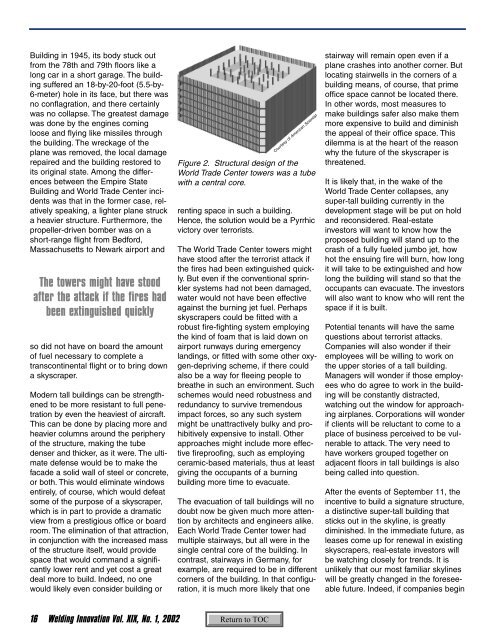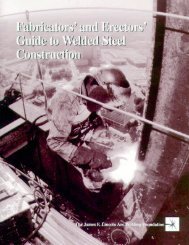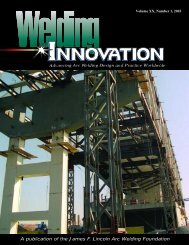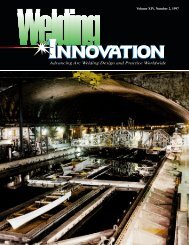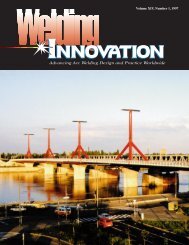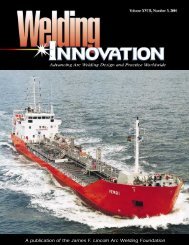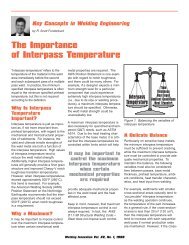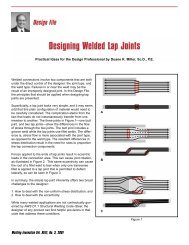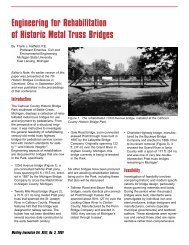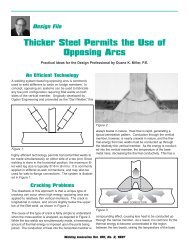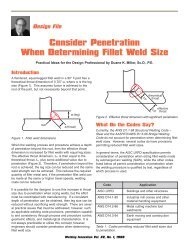A publication of the James F. Lincoln Arc Welding Foundation
A publication of the James F. Lincoln Arc Welding Foundation
A publication of the James F. Lincoln Arc Welding Foundation
Create successful ePaper yourself
Turn your PDF publications into a flip-book with our unique Google optimized e-Paper software.
Building in 1945, its body stuck out<br />
from <strong>the</strong> 78th and 79th floors like a<br />
long car in a short garage. The building<br />
suffered an 18-by-20-foot (5.5-by-<br />
6-meter) hole in its face, but <strong>the</strong>re was<br />
no conflagration, and <strong>the</strong>re certainly<br />
was no collapse. The greatest damage<br />
was done by <strong>the</strong> engines coming<br />
loose and flying like missiles through<br />
<strong>the</strong> building. The wreckage <strong>of</strong> <strong>the</strong><br />
plane was removed, <strong>the</strong> local damage<br />
repaired and <strong>the</strong> building restored to<br />
its original state. Among <strong>the</strong> differences<br />
between <strong>the</strong> Empire State<br />
Building and World Trade Center incidents<br />
was that in <strong>the</strong> former case, relatively<br />
speaking, a lighter plane struck<br />
a heavier structure. Fur<strong>the</strong>rmore, <strong>the</strong><br />
propeller-driven bomber was on a<br />
short-range flight from Bedford,<br />
Massachusetts to Newark airport and<br />
The towers might have stood<br />
after <strong>the</strong> attack if <strong>the</strong> fires had<br />
been extinguished quickly<br />
so did not have on board <strong>the</strong> amount<br />
<strong>of</strong> fuel necessary to complete a<br />
transcontinental flight or to bring down<br />
a skyscraper.<br />
Modern tall buildings can be streng<strong>the</strong>ned<br />
to be more resistant to full penetration<br />
by even <strong>the</strong> heaviest <strong>of</strong> aircraft.<br />
This can be done by placing more and<br />
heavier columns around <strong>the</strong> periphery<br />
<strong>of</strong> <strong>the</strong> structure, making <strong>the</strong> tube<br />
denser and thicker, as it were. The ultimate<br />
defense would be to make <strong>the</strong><br />
facade a solid wall <strong>of</strong> steel or concrete,<br />
or both. This would eliminate windows<br />
entirely, <strong>of</strong> course, which would defeat<br />
some <strong>of</strong> <strong>the</strong> purpose <strong>of</strong> a skyscraper,<br />
which is in part to provide a dramatic<br />
view from a prestigious <strong>of</strong>fice or board<br />
room. The elimination <strong>of</strong> that attraction,<br />
in conjunction with <strong>the</strong> increased mass<br />
<strong>of</strong> <strong>the</strong> structure itself, would provide<br />
space that would command a significantly<br />
lower rent and yet cost a great<br />
deal more to build. Indeed, no one<br />
would likely even consider building or<br />
Courtesy <strong>of</strong> American Scientist<br />
Figure 2. Structural design <strong>of</strong> <strong>the</strong><br />
World Trade Center towers was a tube<br />
with a central core.<br />
renting space in such a building.<br />
Hence, <strong>the</strong> solution would be a Pyrrhic<br />
victory over terrorists.<br />
The World Trade Center towers might<br />
have stood after <strong>the</strong> terrorist attack if<br />
<strong>the</strong> fires had been extinguished quickly.<br />
But even if <strong>the</strong> conventional sprinkler<br />
systems had not been damaged,<br />
water would not have been effective<br />
against <strong>the</strong> burning jet fuel. Perhaps<br />
skyscrapers could be fitted with a<br />
robust fire-fighting system employing<br />
<strong>the</strong> kind <strong>of</strong> foam that is laid down on<br />
airport runways during emergency<br />
landings, or fitted with some o<strong>the</strong>r oxygen-depriving<br />
scheme, if <strong>the</strong>re could<br />
also be a way for fleeing people to<br />
brea<strong>the</strong> in such an environment. Such<br />
schemes would need robustness and<br />
redundancy to survive tremendous<br />
impact forces, so any such system<br />
might be unattractively bulky and prohibitively<br />
expensive to install. O<strong>the</strong>r<br />
approaches might include more effective<br />
firepro<strong>of</strong>ing, such as employing<br />
ceramic-based materials, thus at least<br />
giving <strong>the</strong> occupants <strong>of</strong> a burning<br />
building more time to evacuate.<br />
The evacuation <strong>of</strong> tall buildings will no<br />
doubt now be given much more attention<br />
by architects and engineers alike.<br />
Each World Trade Center tower had<br />
multiple stairways, but all were in <strong>the</strong><br />
single central core <strong>of</strong> <strong>the</strong> building. In<br />
contrast, stairways in Germany, for<br />
example, are required to be in different<br />
corners <strong>of</strong> <strong>the</strong> building. In that configuration,<br />
it is much more likely that one<br />
stairway will remain open even if a<br />
plane crashes into ano<strong>the</strong>r corner. But<br />
locating stairwells in <strong>the</strong> corners <strong>of</strong> a<br />
building means, <strong>of</strong> course, that prime<br />
<strong>of</strong>fice space cannot be located <strong>the</strong>re.<br />
In o<strong>the</strong>r words, most measures to<br />
make buildings safer also make <strong>the</strong>m<br />
more expensive to build and diminish<br />
<strong>the</strong> appeal <strong>of</strong> <strong>the</strong>ir <strong>of</strong>fice space. This<br />
dilemma is at <strong>the</strong> heart <strong>of</strong> <strong>the</strong> reason<br />
why <strong>the</strong> future <strong>of</strong> <strong>the</strong> skyscraper is<br />
threatened.<br />
It is likely that, in <strong>the</strong> wake <strong>of</strong> <strong>the</strong><br />
World Trade Center collapses, any<br />
super-tall building currently in <strong>the</strong><br />
development stage will be put on hold<br />
and reconsidered. Real-estate<br />
investors will want to know how <strong>the</strong><br />
proposed building will stand up to <strong>the</strong><br />
crash <strong>of</strong> a fully fueled jumbo jet, how<br />
hot <strong>the</strong> ensuing fire will burn, how long<br />
it will take to be extinguished and how<br />
long <strong>the</strong> building will stand so that <strong>the</strong><br />
occupants can evacuate. The investors<br />
will also want to know who will rent <strong>the</strong><br />
space if it is built.<br />
Potential tenants will have <strong>the</strong> same<br />
questions about terrorist attacks.<br />
Companies will also wonder if <strong>the</strong>ir<br />
employees will be willing to work on<br />
<strong>the</strong> upper stories <strong>of</strong> a tall building.<br />
Managers will wonder if those employees<br />
who do agree to work in <strong>the</strong> building<br />
will be constantly distracted,<br />
watching out <strong>the</strong> window for approaching<br />
airplanes. Corporations will wonder<br />
if clients will be reluctant to come to a<br />
place <strong>of</strong> business perceived to be vulnerable<br />
to attack. The very need to<br />
have workers grouped toge<strong>the</strong>r on<br />
adjacent floors in tall buildings is also<br />
being called into question.<br />
After <strong>the</strong> events <strong>of</strong> September 11, <strong>the</strong><br />
incentive to build a signature structure,<br />
a distinctive super-tall building that<br />
sticks out in <strong>the</strong> skyline, is greatly<br />
diminished. In <strong>the</strong> immediate future, as<br />
leases come up for renewal in existing<br />
skyscrapers, real-estate investors will<br />
be watching closely for trends. It is<br />
unlikely that our most familiar skylines<br />
will be greatly changed in <strong>the</strong> foreseeable<br />
future. Indeed, if companies begin<br />
16 <strong>Welding</strong> Innovation Vol. XIX, No. 1, 2002


